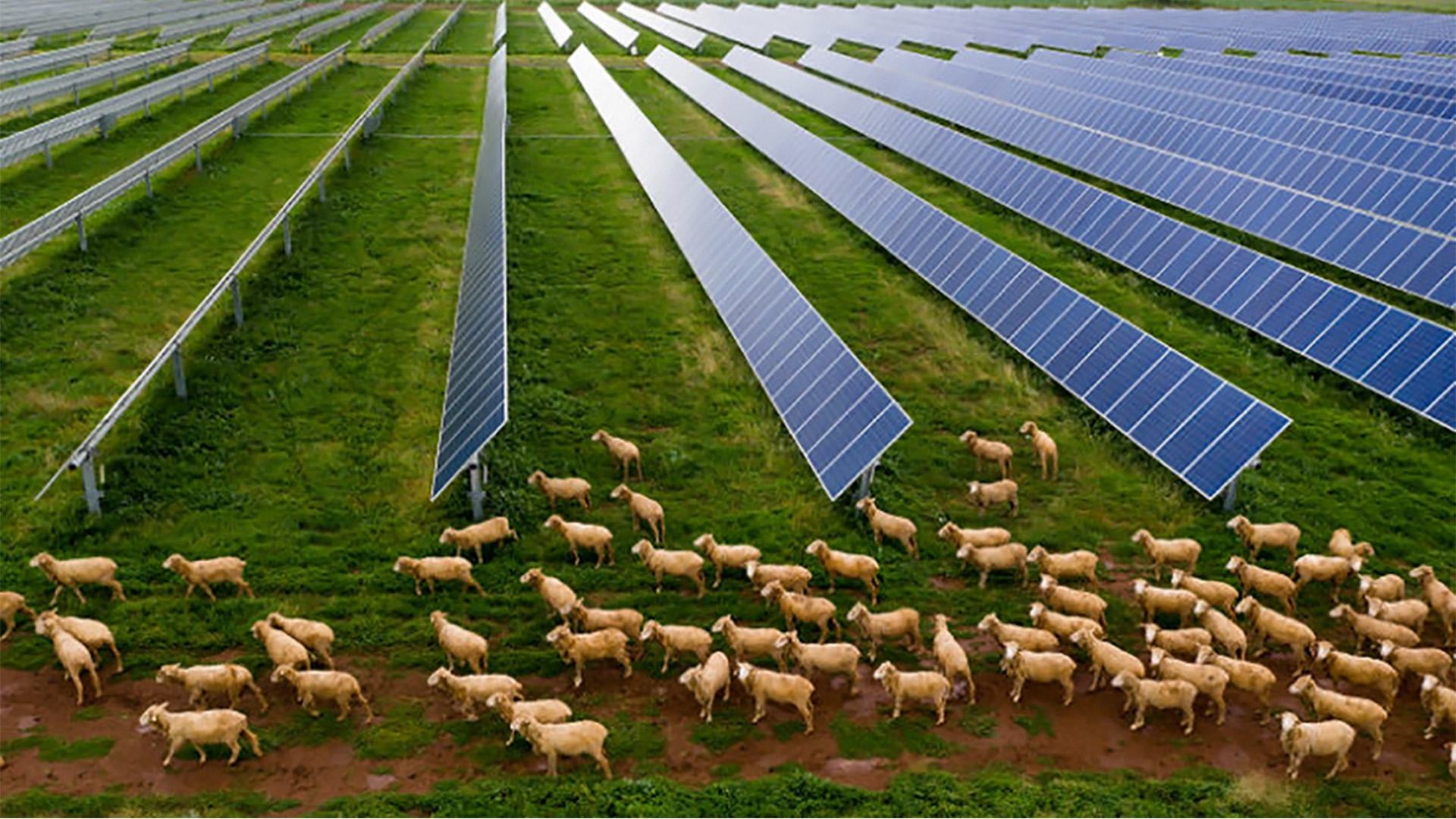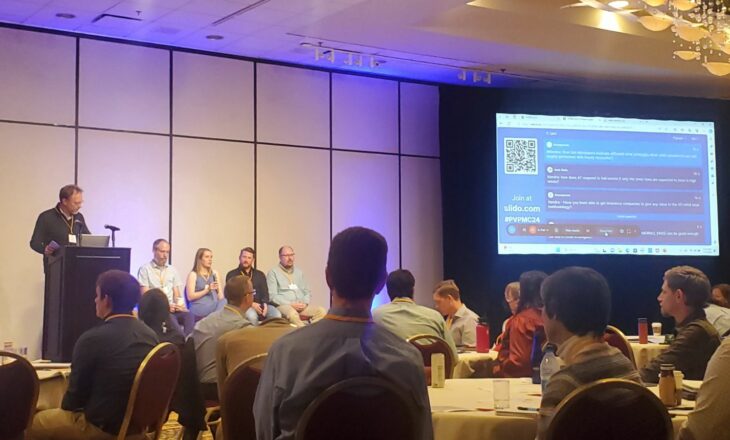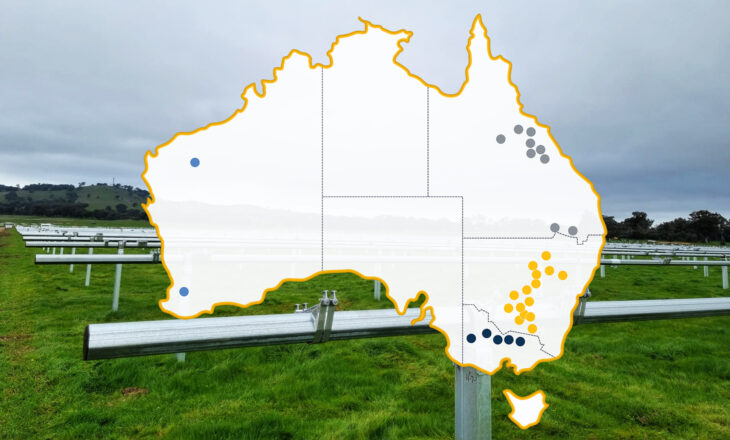
La operación y el mantenimiento de una instalación de energía solar fotovoltaica a gran escala es una propuesta costosa y que requiere mucho tiempo.
Sin embargo, ha habido una innovación única en el funcionamiento de las plantas fotovoltaicas, aunque proviene de una fuente simple y decididamente de la vieja escuela.
El nuevo papel de las ovejas en la reducción de los costes de operación y mantenimiento de las plantas fotovoltaicas
Has leído bien. Las ovejas se emplean ahora como jardineras en los terrenos de las plantas fotovoltaicas, fusionando los mundos de la agricultura y la energía solar de forma mutuamente beneficiosa.
Según el Laboratorio Nacional de Energías Renovables, las instalaciones solares a gran escala podrían ocupar tres millones de acres (1,2 millones de hectáreas) de terreno estadounidense en 2030. Esta expansión está provocando tensiones entre la industria de la energía solar y las industrias de la ganadería y la agricultura que dependen de la superficie para ser productivas.
En lugar de restringir el uso de las tierras de pastoreo útiles únicamente para la producción de energía solar, la solución híbrida del pastoreo solar, como se conoce, para ajardinar y gestionar eficazmente la vegetación de las instalaciones es una solución cada vez más popular y rentable.
¿Por qué “pastoreo solar”?
En 2019, casi 20 estados estaban empleando el pastoreo solar en algún modo, y se espera que ese número crezca aún más a lo largo de 2020, y por una buena razón.
Además de permitir un mayor acceso a tierras clave para los ganaderos, el pastoreo solar también conlleva muchos beneficios para los propietarios y responsables de las plantas solares.
Según un informe de 2018 del Centro Atkinson, elaborado por investigadores de la Universidad de Cornell, las horas de trabajo que normalmente se dedican al manejo mecánico de la vegetación y a la utilización de pesticidas se redujeron con el uso del pastoreo solar. De hecho, se necesitaron 2,5 veces menos horas.
El uso del pastoreo solar también promueve la responsabilidad medioambiental y reafirma el compromiso de una planta con la sostenibilidad. También podría venir acompañado de incentivos, sobre todo a medida que crece su popularidad: Massachusetts ya ofrece incentivos para el pastoreo solar, y otros estados podrían seguir su ejemplo en breve.
Además, las ovejas son el animal perfecto para este trabajo. Son lo suficientemente pequeñas como para caber debajo y alrededor de las instalaciones, pero no causan los estragos que pueden provocar las cabras y otros animales, ya que normalmente sólo pastan lo que se supone que deben: la vegetación.
Ciertamente, hay que tener en cuenta algunas consideraciones importantes, sobre todo por parte del propietario del rebaño, como rotar a las ovejas para evitar el sobrepastoreo, evitar los terrenos baldíos que puedan dañar a los animales, etc. Pero los beneficios de practicar el pastoreo solar compensan este riesgo con una cuidadosa previsión y planificación.
Diseño eficiente de la planta y de la operación y mantenimiento
En el caso de las plantas fotovoltaicas, un buen diseño significa tener en cuenta todas las estrategias innovadoras para reducir los costes de operación y mantenimiento desde el inicio del proyecto.
El pastoreo solar puede formar parte de un esfuerzo holístico para reducir esos costes, sobre todo si se complementa con otras decisiones del proyecto.
Las decisiones tomadas en el diseño y la selección de componentes también afectan a la operación y mantenimiento a largo plazo.
La elección de un seguidor con una arquitectura centralizada puede reducir significativamente los costes de operación y mantenimiento a largo plazo, ya que los componentes de vida útil más corta, como las baterías, los dispositivos electromecánicos, etc., en los diseños de seguidor descentralizados pueden aumentar los costes de mantenimiento, especialmente después de que expire la garantía habitual de 5 años. Lo mismo ocurre con el gran número de componentes de las soluciones descentralizadas: cuantas más piezas, más posibilidades de fallos y tiempos de inactividad.
Si nos centramos en el ideal de “mantenimiento cero” y ponemos el tiempo de funcionamiento, el menor mantenimiento correctivo y las soluciones creativas, como el pastoreo solar, a la cabeza de la lista de prioridades de una planta, los costes de funcionamiento y mantenimiento pueden reducirse considerablemente.
ARRAY Technologies ha sido una empresa innovadora en el sector de la energía solar, proporcionando soluciones que acentúan el valor a largo plazo y optimizan el rendimiento. ARRAY fabrica robustos seguidores solares, pero reconoce que las soluciones innovadoras de operación y mantenimiento, como añadir ovejas a la ecuación, forman parte de una estrategia flexible y adaptable que puede aumentar la eficiencia general y reducir los costes durante los 25-30 años de vida útil de una planta solar fotovoltaica.
El pastoreo solar en acción
También es una vía de doble sentido: al tiempo que proporciona eficiencia en la reducción de costes para los operadores de las plantas, el pastoreo solar puede suponer una fuente de ingresos adicional para los propietarios que alquilan terrenos a las plantas, en lugar de trasladar los rebaños a terrenos ya utilizados para la energía solar. Una cosa es cierta: el uso de ovejas para el pastoreo solar está impulsando la puesta en práctica de incentivos y programas piloto en todo el mundo, ya que la industria busca implementar las mejores prácticas de O&M más eficientes.
Los seguidores solares de un solo eje DuraTrack® de ARRAY ya han comenzado a ser utilizados en una granja de Australia en la que el pastor de ovejas de Dubbo, Tom Warren, ha arrendado parte de sus tierras a Neoen para construir una granja solar de 20 megavatios. Esta estrategia ha diversificado el flujo de ingresos de Warren: además de la producción de lana, también está cobrando un alquiler por la parte del terreno que ocupa la planta.
En ARRAY, nuestro objetivo es maximizar la producción, y nuestro seguidor DuraTrack® HZ v3 ofrece un valor, una fiabilidad, una durabilidad y una calidad sin precedentes.
Esperamos que nuestras soluciones, las mejores en su categoría, aparezcan en todo el mundo en los esfuerzos de pastoreo solar como parte del impulso de la industria hacia la adopción de la práctica a una escala mucho mayor.
¿Cómo empezar?
La Asociación Americana de Pastoreo Solar (ASGA) trabaja activamente para informar a los operadores de plantas y a los agricultores sobre el uso del pastoreo solar y para promover esta práctica en las instalaciones solares.
Además, la ASGA facilita la investigación, las mejores prácticas y mucho más, al tiempo que ofrece membresías y una herramienta para conectar a los agricultores con proyectos solares interesados en emplear el pastoreo solar.
Para obtener más información, póngase en contacto con la ASGA o con ARRAY Technologies para saber cómo podemos ayudarle a mejorar las operaciones y las prácticas de gestión de su planta solar.
Click here for other articles by this author



